Southern Pines Golf Club
North Carolina, United States of America
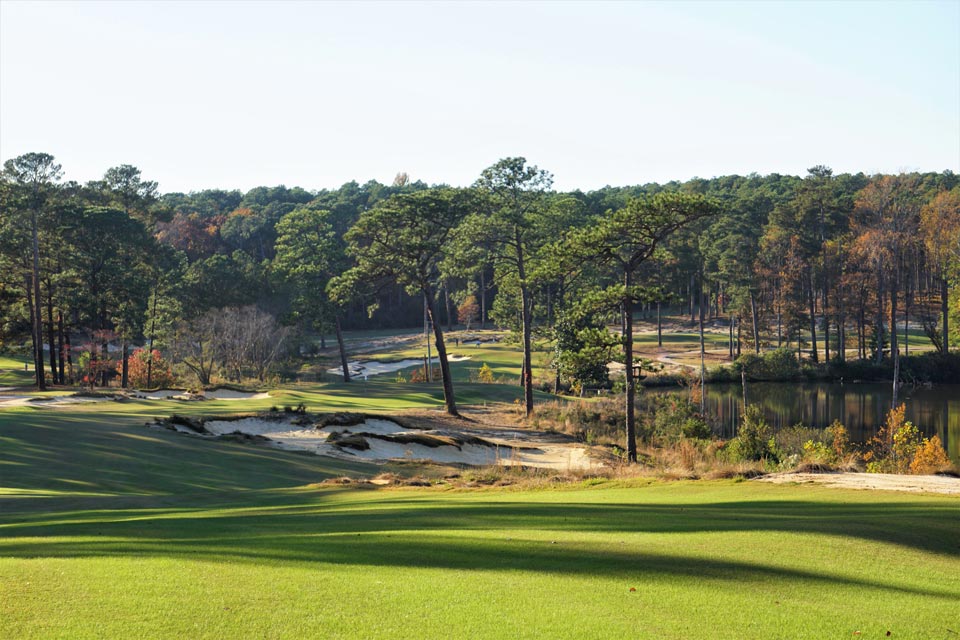
Southern Pines GC enjoyed a small but loyal following for decades. Courtesy of an ownership change and the ensuing Kyle Franz re-do in 2021, its appeal has broadened considerably. Now, the architectural features rival the merits of the exquisite Donald Ross routing.
This profile is highly personal and biased as Southern Pines Golf Club has been my home course for over twenty years. It is the only place where I have stood on a first tee 1,000+ times. I have always returned home happier and more relaxed than when I left. Some of that is the charm of golf but a lot of it is the allure of this particular property and its holes.
As to the course’s history, no one better than Chris Buie to lend perspective. He has been my constant playing partner here, as well as the author of books on Pinehurst and Donald Ross. He grew up in the 1970s and 1980s playing Southern Pines and provides the following historical context:
Southern Pines Golf Club started out like so many others. There was a stretch of land not far from the town center and the locals decided to give it a go. Importantly, they enlisted the aid of a pair of Scotsmen, MacNab and Peacock. Both were Donald Ross proteges and the course, though rudimentary, was off to a good start. The 9-holes (golfers at the time played a par three from a tee left of today’s fourth green down to a green near the forward tee on fifteen) stayed that way until the man himself rolled all of seven miles over from the twin village. There were endless acres of hills and knolls on sandy soil some called Norfolk loam. The tumbling landforms galore truly comprised a dream canvas and Ross went to work, turning the holes in different angles, to change up the golfing propositions – right to left, left to right, side hill, uphill, downhill, longish, shortish and so forth – all meted out with an innate sense of rhythm.
At its core, we have a 100+ year old Ross routing that he did relatively early in his bourgeoning career, well before Mid-Pines and Pine Needles for instance. The kicker is the rolling, sandy land, arguably the finest canvas in Moore County upon which a course has been built. Every hole goes up or down at least twenty feet and yet the golfer never complains of hilliness. It epitomizes what it means to be in the Sandhills of North Carolina. The green to tee connections are tight and the course is a walker’s delight. Homes brush against the course at the fourth and fifth holes, otherwise, the golfer is cocooned in nature.
I first played here in 1997 at a friend’s suggestion. I had never heard of it and came to learn that the Elks organization owned it. As per its charter, the Elks spend their money on the good of the community, not advertising its golf course. I moved to Southern Pines in 2000 from Australia, in part because I knew I could afford to join here. Golf has always been part of my D.N.A. and the opportunity to play this course regularly had enormous pull. Better yet, the course was generally empty after 5pm, which is when I play 90% of my golf. Over the long summer months, it was readily possible to tee off at 5:30pm and comfortably make 18 holes in 2 1/2 hours carrying my bag. The Elks Lodge and clubhouse weren’t architecturally impressive (nor was the range) but that didn’t matter. I was here to play golf.
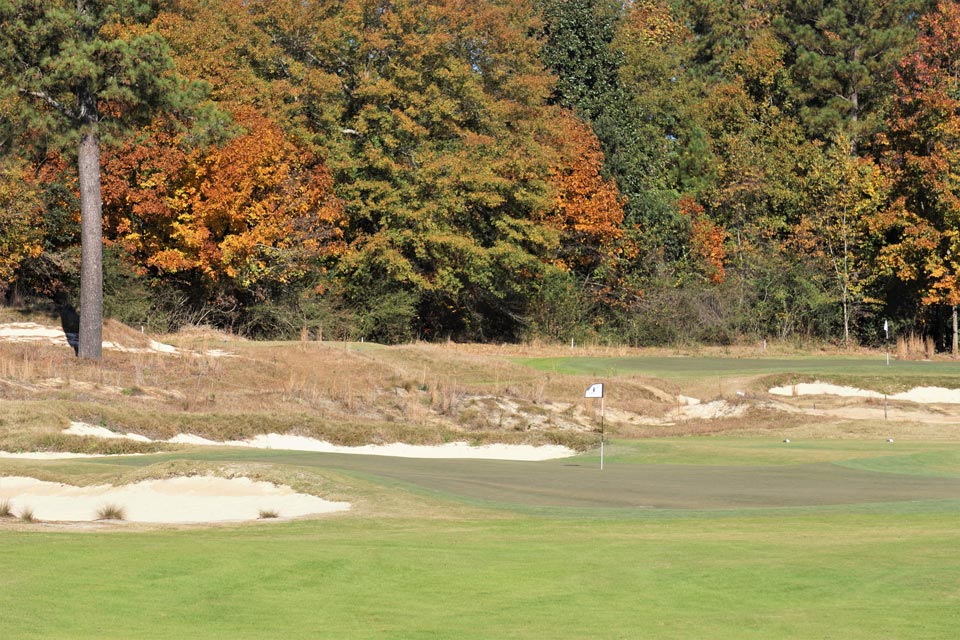
Contained within a 100-yard square block of property, we find the 17th green in the foreground with the 1st green behind. In between the two is the 18th tee and the back tee on 2 is a scant twenty paces from the 1st putting surface.
From 2000 to 2020, the course was good enough to play again and again and be content, so magical is the Ross routing over the land. Plus, the pacing was excellent as the holes benefited from the classic Ross give-and-take. Take the stretch from the second through the sixth. The second is a reachable par five to a severe green and while many strong golfers get near it in two, getting down in two is another matter. This par 4 1/2 hole is followed by a downhill 200 yard one shotter and an equally tough uphill 410 yard two shotter. Standing on the fifth tee, you might be feeling a bit bruised, but Ross then throws into the mix another three shotter that can be reached in two if the golfer can turn his drive right to left and have it bound down the hill. The ‘give’ of this potential birdie hole is followed by Ross’s ‘take’ at the sixth, which is the course’s longest two shotter at 440 yards. And so it goes for the rest of the round, with tough holes sprinkled among more ‘gettable’ ones. Hope persists throughout the round, which is a neat attribute that too few modern courses enjoy. The Ross routing and his pacing of the holes were the undoubted backbone of the course during this period.
To be clear, obvious flaws existed, especially to Ross aficionados. An architect had re-done the greens in the early 1990s and too many featured distinct tiers. Though non-Ross in appearance, the modernized greens did afford interesting hole locations. From a design perspective, the most woeful shortfall was its non-existent fairway bunker schemes. Indeed, the majority of the holes didn’t have a single fairway bunker and the ones that did were often shallow, small saucers, poorly positioned, and out of scale with their surrounds. Without doubt, the challenge off the tee was confined to how the holes fell across the land. While that is certainly a foundation for good golf, hitting anywhere in the fairway sufficed and few clever playing angles presented themselves.

As seen in 2010, the solitary bunker on the inside of the dogleg at the 18th was a mere 175 yards from the back markers and was too small to serve its purpose of challenging the golfer looking to take a shortcut.

A series of bunkers (some visible and some not) now extend for 60 yards in length on the inside of the dogleg.
The saving grace was the green placements. Typical of a Golden Age course, as the player approached the greens, the challenge stepped up several notches. Ross’s greens occupied the high spots and deep greenside bunkers exacerbated the requirement for good iron play.
Ultimately, in 2019, the Elks sold the course to Kelly Miller and the Pine Needles Resort. This was the break that the course deserved: It needed to be run by a golfer for golfers. The property is so special and Ross’s routing so good, that it would have been a shame if the course merely limped along ‘as is.’ Miller had always been a fan of the course’s bones and waited for the right opportunity. In the meanwhile, he had struck up a relationship with architect Kyle Franz, first hiring him at Mid Pines in 2013 and then Pine Needles thereafter. Franz’s work at Mid Pines was viewed as one of the country’s best restorations that year and the world will appreciate his talents when the U.S. Women’s Open is contested at Pine Needles in June, 2022. For his part, Franz initially worked in the area in 2010 at Pinehurst No. 2 for Coore & Crenshaw and had subsequently made it his home, living off the eighteenth tee at Pine Needles.
In December 2020, Franz and crew started work. Matt Smallwood, Eamon Sullivan, and the Three Amigos (Rosendo Rosas and cousins Eleuterio and Juan Velasco) are the backbone of Franz’s crew and were ‘all hands on deck’ from the get-go. Additionally, Franz brought in other extremely talented shapers to assist along the way, including Dan Proctor, Benjamin Warren, Jeff Stein, Daniel Loveridge, Jose Avila, Dwayne McKinnon, and Robert Nelson. Rounding out the team were the services of newcomers Sam Tardiff, Mike Koprowski, Eduardo Rojas, and Peter Crowe, all of whom proved invaluable as well.
Miller wisely requested that they focus their early energies on the holes around the clubhouse, as Miller was keen for them to paint a picture of what the rest of the course would look like. From the get-go, more sandscape and short grass emerged. Essentially, the golfer was going to be presented with many more sandy obstacles with which to contend while simultaneously, being given more fairway area around which he could skirt such hazards. Pine trees were felled so that the playing corridors could be widened and before long, something wonderful started to emerge over the winter months.
The course’s greatest weakness – a paucity of obstacles that made you think from tee to green – was swiftly eradicated. A variety of sandscapes were teased from the ground. Some are bunkers and others are hard pan areas that don’t lend themselves to a typical explosion shot. Still, they all need to be avoided. Over ten acres now exists of exposed sand and yet, the amount of fairway grass increased by over 30%. As the scale of the course expanded, numerous, thought-provoking playing angles emerged. Hitting driver is not an automatic decision anymore as opportunities abound to get yourself into regrettable lies. Regardless, little time is wasted searching for golf balls. It is the best of all worlds.
As an interesting side note, the club owns a third nine that lays fallow and grasses, even cacti, were imported from it and handplanted. What is really impressive was how aged the new sandscapes appeared from the start. For example, the sandy features in the three photographs below were less than one year old when the pictures were taken! Franz’s prior ten years of working in Moore County and the team that he assembled served him well when it was show time.

The variety and composition of sandy obstacles is top drawer. Above is the view from 70 yards short right of the 1st green.
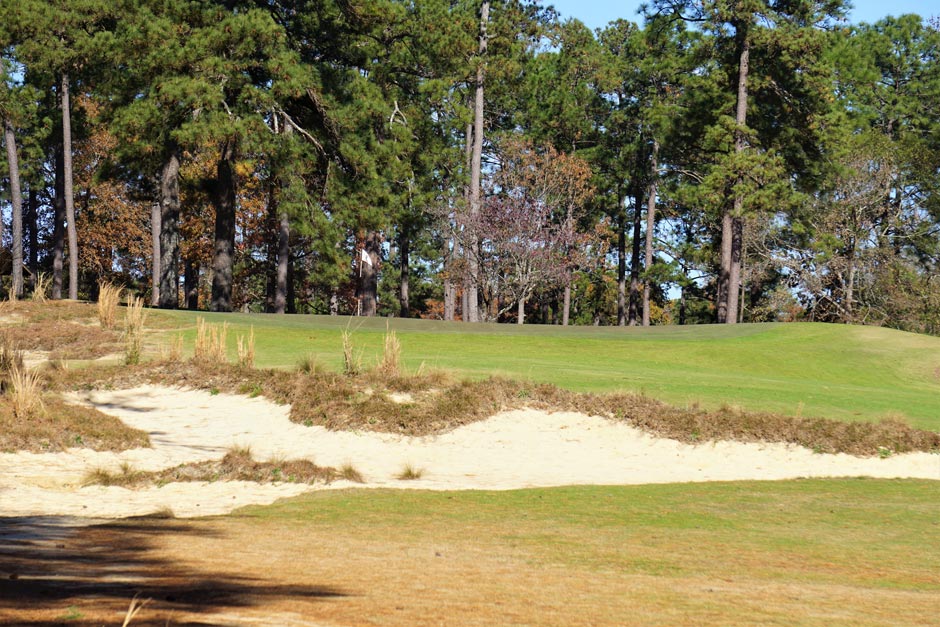
Franz reintroduced central hazards multiple times as a key component, including this one that slashes across the 15th fairway.
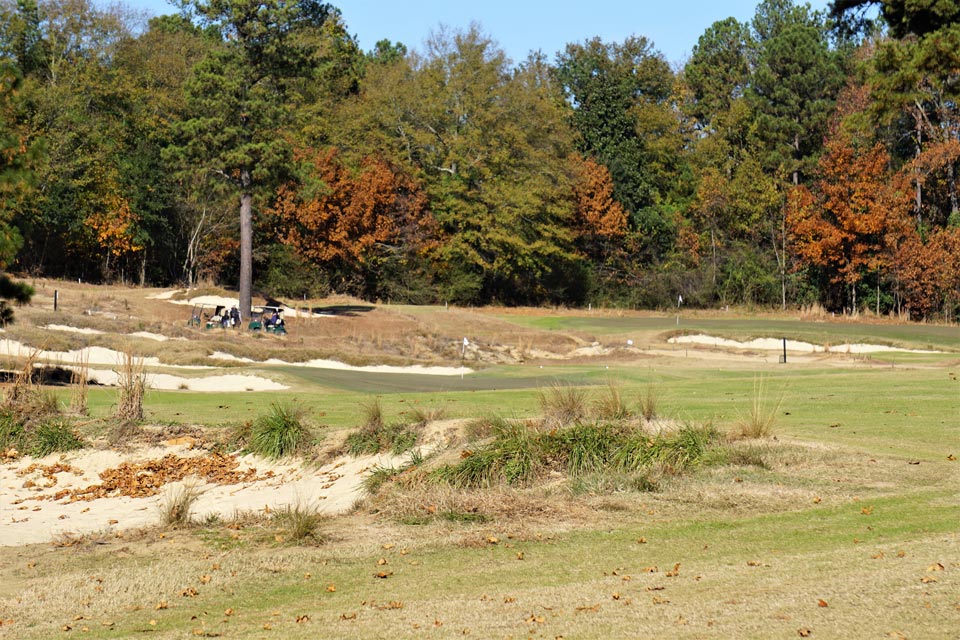
The various grassing schemes including on the bank behind the green lend a sense of ‘instant maturity.’
For sure, the glamour part of the overhaul was the tee to green aspect. However, the real guts of the project came in June, 2021. It was time to shut down the course and rebuild every putting surface. At this point, expectations were sky high and yet, re-introducing a set of greens more in keeping with Ross was no mean task. Happily, the eighteen putting surfaces that emerged might be the star of the entire project. They will never be recognized as such as it is much easier to fawn on the sandscapes and the mesmerizing long views but the putting surfaces are equally things of beauty. Fourteen of the eighteen feature false fronts, signifying just how many Ross had perched up on some landform. Many of the greens feature soft sides.
To be clear, the greens that Franz built were never intended as a faithful restoration of what existed at Southern Pines in the late 1930s or 1940s, in part because no accurate records exist. In 1914, Ross left the course with eighteen sand greens and it wasn’t until the mid-1930s that Angus Maples grassed them. As Franz notes, “These green contours are my interpretation of what Ross was building at Pinehurst No. 2 during the 1930s. I say that after having scoured scores of black and white photographs in the Tufts Archives. In particular, the wild ones I saw of the 2nd, 9th and 17th greens were in the forefront of my mind as the project progressed. Take the photograph below of the 2nd green. If it was in black and white, it would look similar to what was on the ground at Pinehurst No. 2 back in the day.”
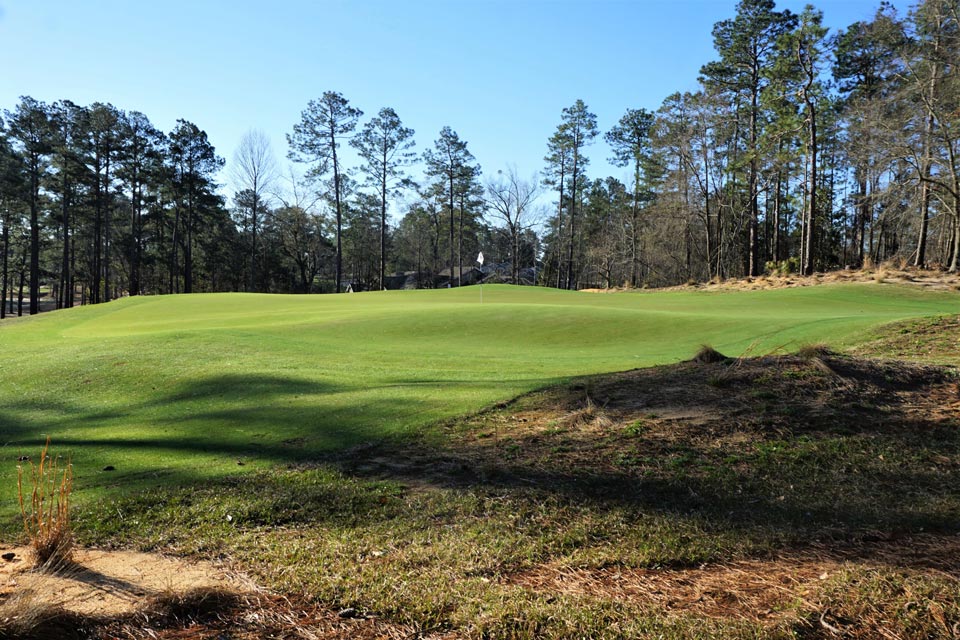
The new putting surface at the 2nd is full of character, including a false front and false side.
Between the soft sides, false fronts, and the way some greens tilt to the rear, many more balls ‘de-green’ than ever before. That is certainly something that Ross embraced with the greens at Pinehurst No. 2 being in a class by themselves in that regard. At Southern Pines, the golfer is asked a host of interesting questions throughout the round by this new set of greens. Learning where the best misses are is a process – and proving to be an interesting one at that.
Holes to Note
First hole, 375 yards; This opener encapsulates how far the design came in 2021. Before, there were two small bunkers, left and right of the green – and that’s it. No other sand from tee to green and the fairway was linearly presented and artificially narrow within the spacious confines of pines. Little thought was required from the tee and the player reached for driver every time as only the most wayward tee ball could find trouble. Now look at it! From Franz’s perspective, “I really admire how Ross expanded on the subtle ridge in the fairway by adding a right foreground bunker that makes the 1st fairway look like a narrow target when, in fact, it is the widest on the front nine where the average player hits.”
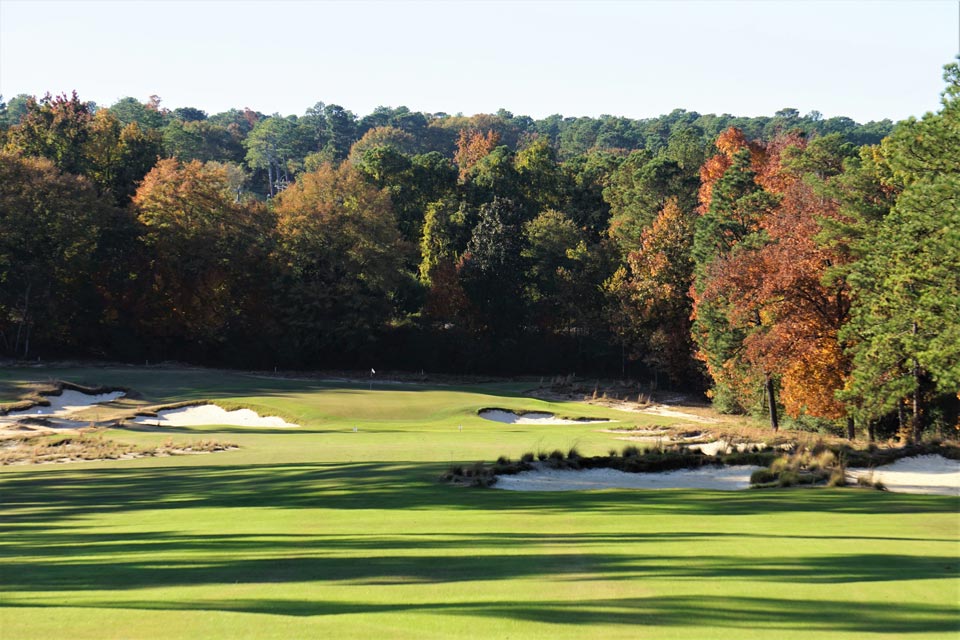
Franz brought back Ross’s foreground bunker and reinstalled playing angles galore at the 1st. Once again, the player needs to first check the day’s hole location to decide which side of the wide fairway he should aim.
Second hole, 565/490 yards; A stellar example of how different tees dramatically impact a hole. Franz quite cleverly created the room to add a new tee in the property’s far corner, stretching the hole 75 yards in length and turning it into a true three shotter. From this new back marker, a 240-yard drive hits into the upslope of the far hill, stunting much roll-out. A three wood or hybrid is then required to carry a diagonal hazard ahead, leaving the golfer with a ~ nine iron approach. Meanwhile, played from the white markers, a totally different scenario unfolds. One’s tee ball carries the crest of the hill and scampers forward some 40 yards. Indeed, the golfer can darn near reach the same diagonal hazard that a hybrid was required to carry for one’s second from the back tees. From there, he has a downhill stance/lie from ~220 yards to an uphill green. Getting a clean strike on a ball from a downslope is always tricky. In this case, it is worth noting that there is a comparably flatter area long right off the second tee. If the golfer can find it, his second shot is much easier. Franz elected to remove a deep right greenside bunker, further rewarding the golfer who plays along the hole’s more dangerous right side where a boundary line extends from tee to green. From either tee, the hole is fascinating and that is repeated at several other holes too (namely the fifth, tenth, eleventh, and fifteenth) whereby the blue and white markers yield wildly different holes. Bottom line: have fun mixing up the tees. One of the great mistakes that ‘card and pencil’ golfers make is slavishly playing from one set of tees. Their fixation with entering a score for handicap purposes trumps the fun gained by experiencing holes from different starting points.
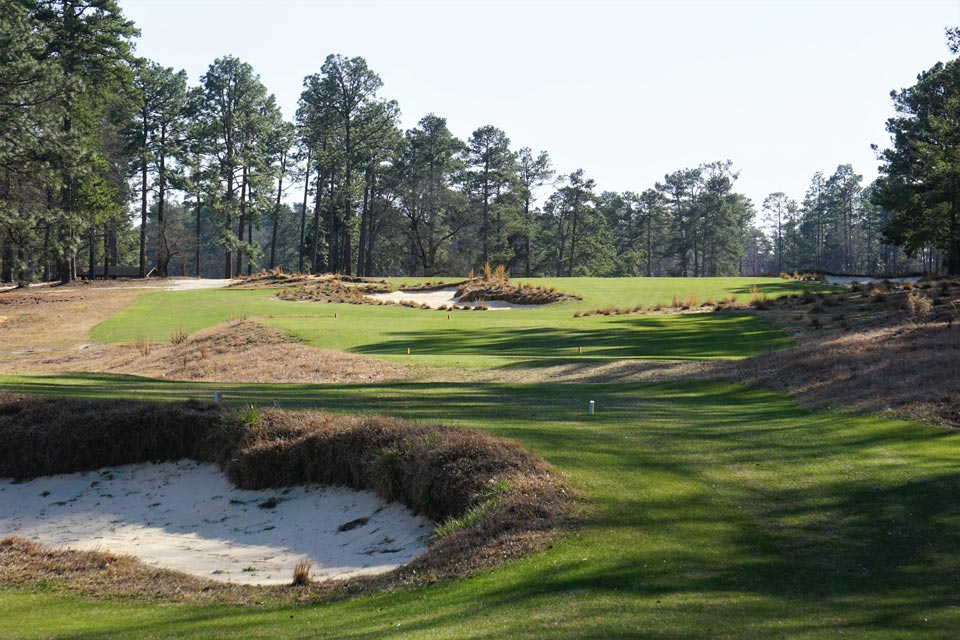
From the newly installed tee in the back corner of the property, the central hazard in the distance requires a carry of 235 yards, which is no certainty as the shot plays uphill and frequently into the prevailing wind. This is the first of several blind drives over hillcrests. Fortunately, Ross felt no compunction to alter the land to provide ‘better’ optics. Too many modern architects might cut a ‘v’, thus making the dual mistake of depriving such drives of mystery while also making them more artificial in appearance.
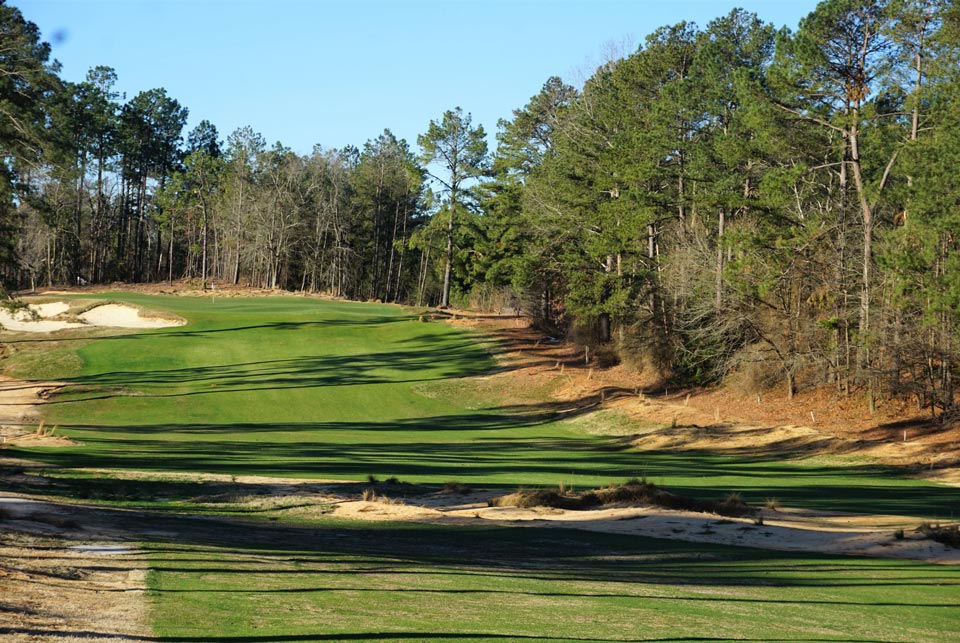
Though the 2nd green is reachable in two from certain tees, the golfer will have to do so by hitting from a downslope to a sharply uphill green.
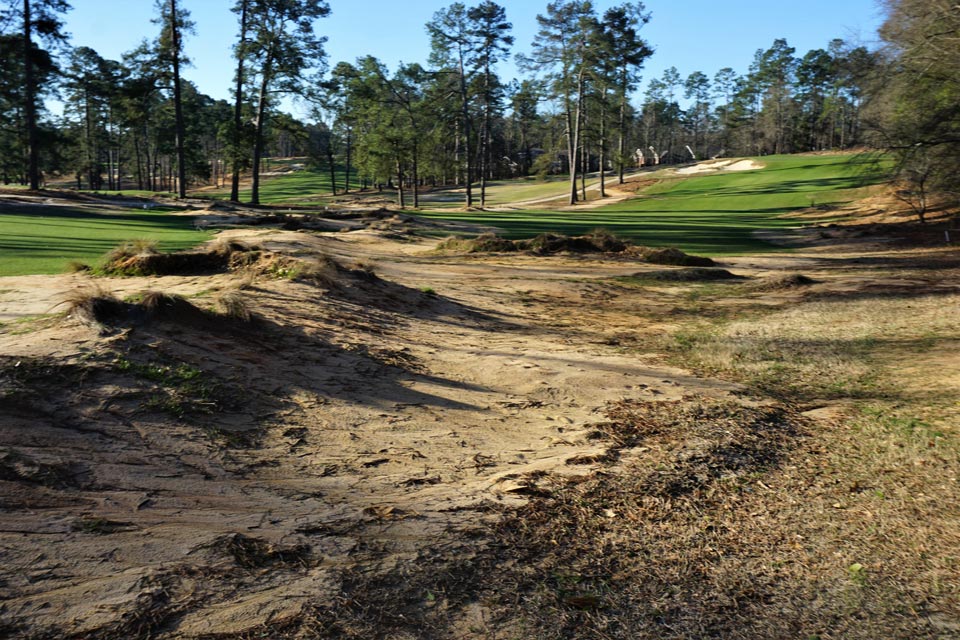
This cross hazard is a mix of bunkers and hardpan. Much it will go untended, so bad lies are part of the equation.

As an added bonus, and in the finest U.K. tradition, a rail line passes 40 yards to the right of the 2nd green.
Third hole, 200 yards; Standing on the elevated tee, the golfer soaks in the view of the entire putting surface, something that happens less than half the time over the course of a round. Yet, taking advantage of everything so neatly laid out before the player is not easy as the green contours installed by Franz here are bedeviling to the point where a former member of the University of North Carolina at Chapel Hill golf team considers this the hardest par over the course of a season. Tee balls that land near the false front, left or rear are routinely shrugged away. Franz takes pride that the green configuration and its slopes favor hitting in a draw to middle left hole locations while a high fade is in order for the back right ones. Asking the golfer to hit different shape shots certainly keeps the asks of the course fresh, round after round.
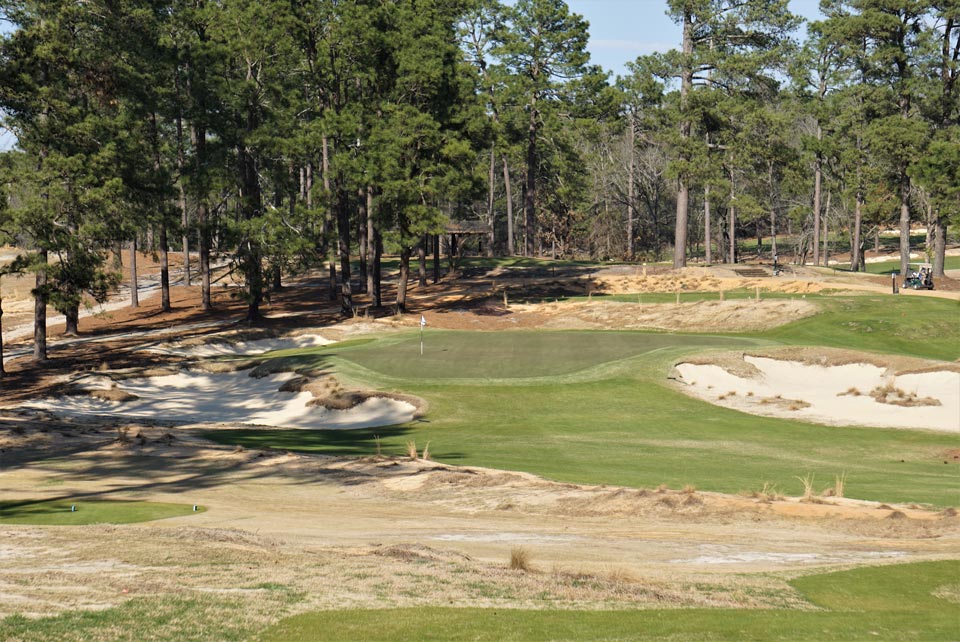
Tee balls that come up just short of this hole location end up eight paces back down the hill while a slight pull sends balls into the gathering left hand bunkers.
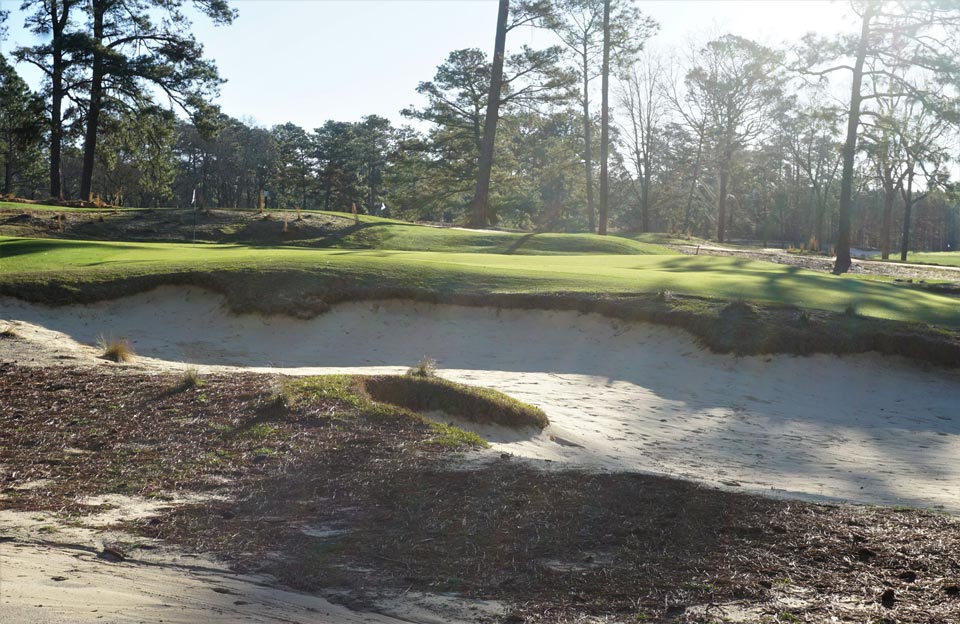
As seen from the left, lots to take with the 3rd green. There is the false front, how the left side rolls over, and how the back and right rise up to present their own interesting hole locations. The key is that all the contours flow well together and none of the movement is abrupt or artificial.
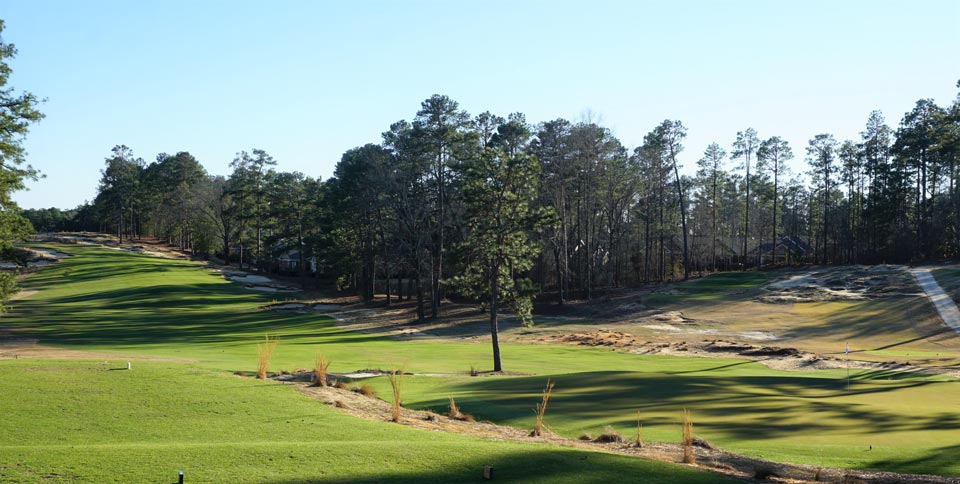
Proper golf – the snug relationship between the 3rd green (right) and 4th is evident.
Fourth hole, 410 yards; Measuring 6,600 yards from the back markers, some golfers mistakenly think they will have an easy time of things. Combine the number of times that drives hit into hills with the number of overtly uphill approach shots, and Southern Pines plays longer than the score card suggests. Note the hog’s back fairway in the photograph below that Ross so effortlessly incorporated into the routing.
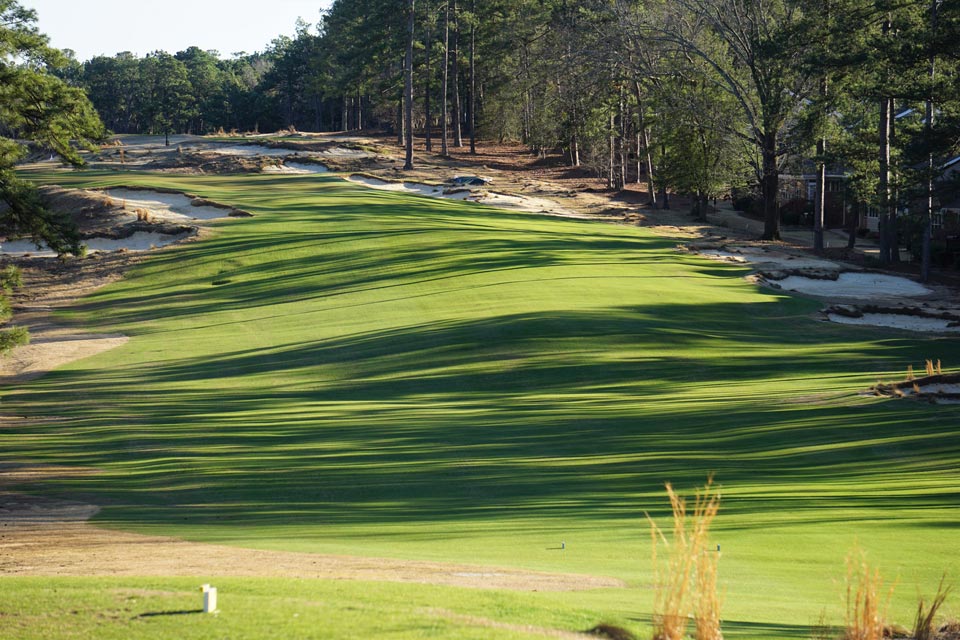
Note how the wide fairway stretches side to side but the angle of the green rewards those who approach it from the right, which is precisely where Franz staggered in a series of bunkers.
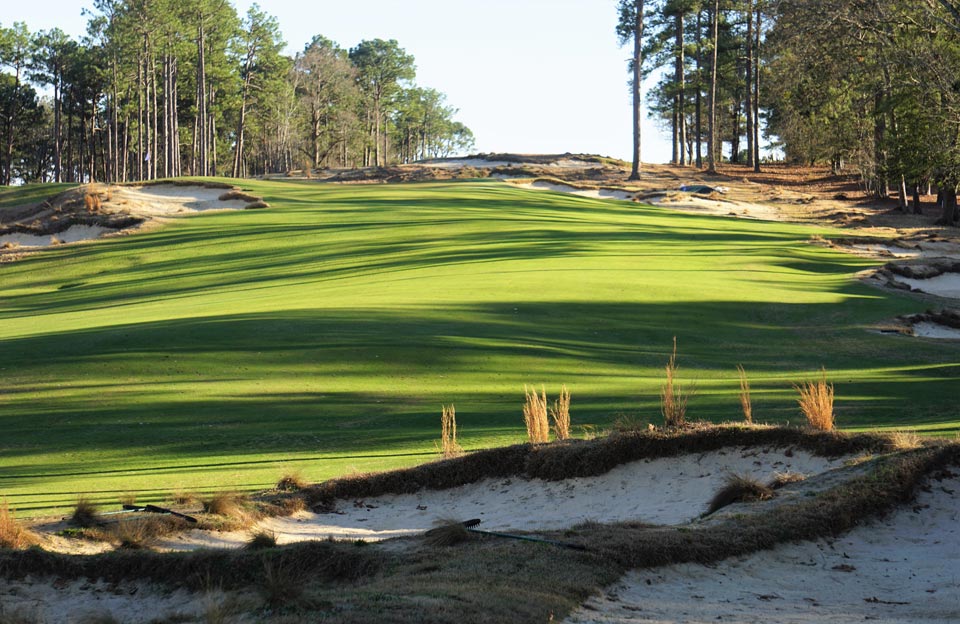
Flirting with the bunkers along the right provides the ideal angle into the uphill green.

As seen from behind, note the soft bowl depression prior to the hole. Anything slightly short gets sucked into it and is whisked away.
Fifth hole, 535 yards; We now enter the portion of the property where Ross extended the course in 1913/14 and the manner in which he captures a twenty-five foot drop in elevation at the 240-yard mark from the tee is terrific. Can the good club golfer hit a draw on this slight dogleg left and have his/her tee ball receive a turbo-kick off the downslope, thus bringing the green within reach in two? The appeal of trying to hit the proper shaped tee ball never wanes and leaves one wondering (marveling!) how Ross managed to string hole after hole together whereby the landforms influence play in alternating ways. Sure, Southern Pines enjoys great topography, but that natural advantage could have been readily squandered in the hands of lesser architects. Franz added four cross hazards (here, the second, twelfth and fifteenth holes), all of which are much in keeping with Ross’s work in Pinehurst in the 1910s and 1920s. In fact, Franz very much admires – and even prefers – how ‘aggressive’ Ross was in those decades compared to some of his later work. These cross hazards make the course, first and foremost, a much better driving test. At the fifth, if the golfer doesn’t find the fairway off the tee and gets tangled up with sand or rough at the top of the hill, the odds of carrying the cross hazard greatly diminish.
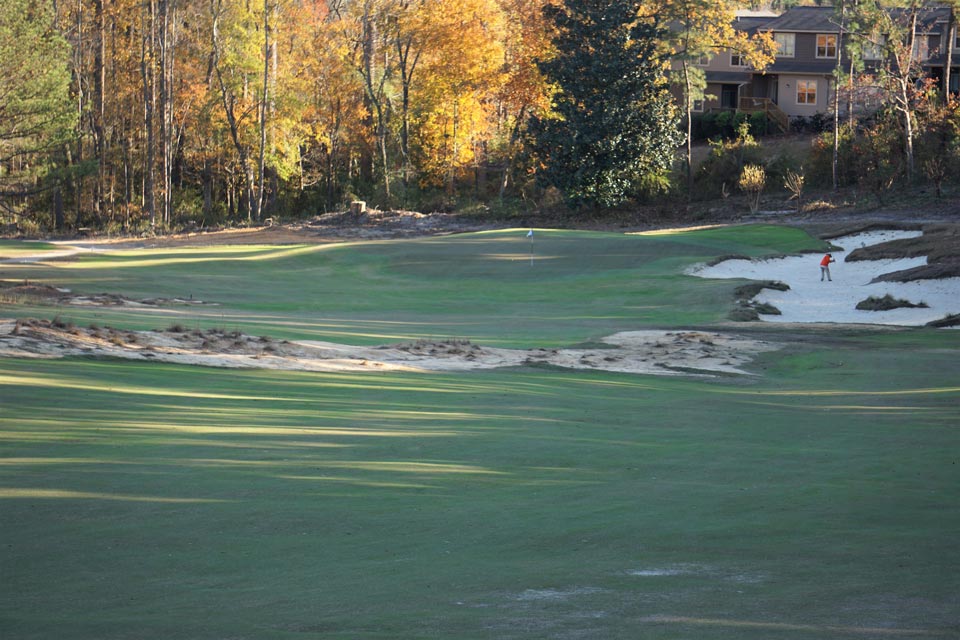
Variety is the name of the game in architecture. In contrast to the green at par five 2nd, the green at the 5th is below the golfer and is an extension of fairway. Whereas a draw is rewarded with a long approach at the 2nd, here a fade is optimal.
Sixth hole, 440 yards; A study of Google Maps reveals a series of wetlands and lakes bisects the property. The original architects stayed away from the low-lying areas, but Ross hopscotches the golfer over it twice, both coming and going. The first time occurs off this tee, which Ross put right beside the lake so that only a topped tee ball could possibly find it. As opposed to the last hole which elbows left and downhill, this one swings right and uphill. After a power fade, the golfer is likely left with something close to a hybrid. Again, full marks to Franz for how he and his team recontoured this green. Before, the entrance to the elevated putting surface was too abrupt. Balls hit from ~200 yards would routinely hit the bank – and be rebuffed. Considering this is the course’s longest two shotter, that is un-Ross like and not good architecture. Franz and team lowered and floated the front of the putting surface out more into the fairway. Now, many more players experience the thrill of seeing their long approach climb onto the putting surface. In fact, having a ball do so is one of the most rewarding moments of the day. This is another prime example whereby the golf has been dramatically enhanced, even while playing within the same corridor.
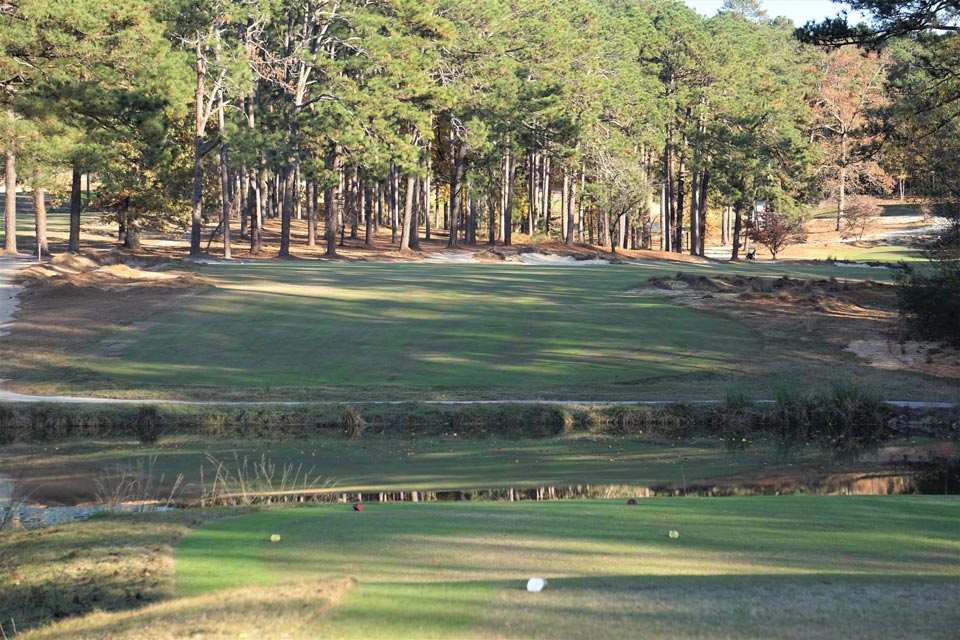
The 6th heads across the waterway to higher land.
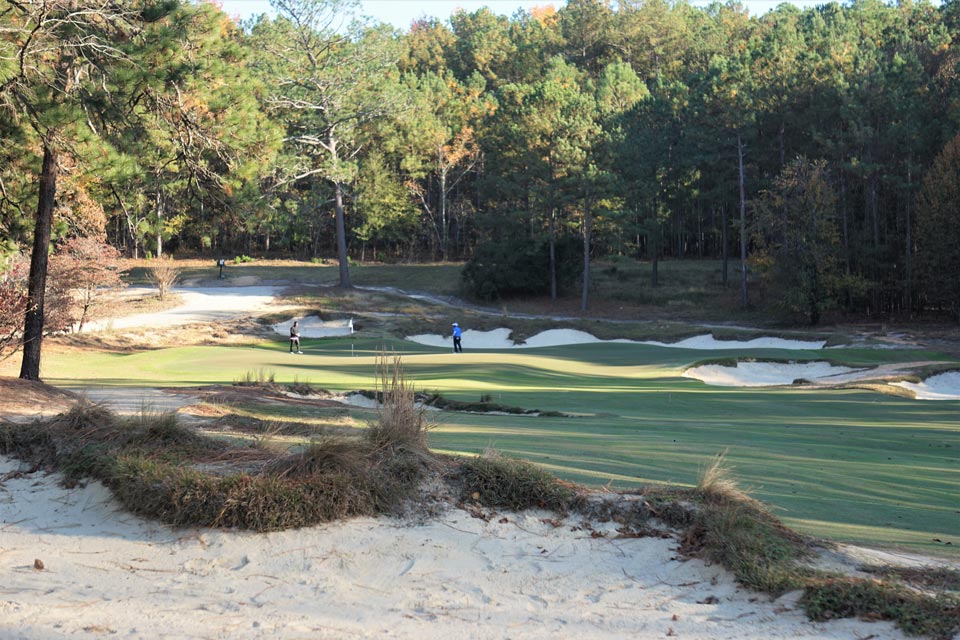
As seen from the outside of the gentle dogleg right, the golfer is still ~200 yards from the green. Can he chase one up?
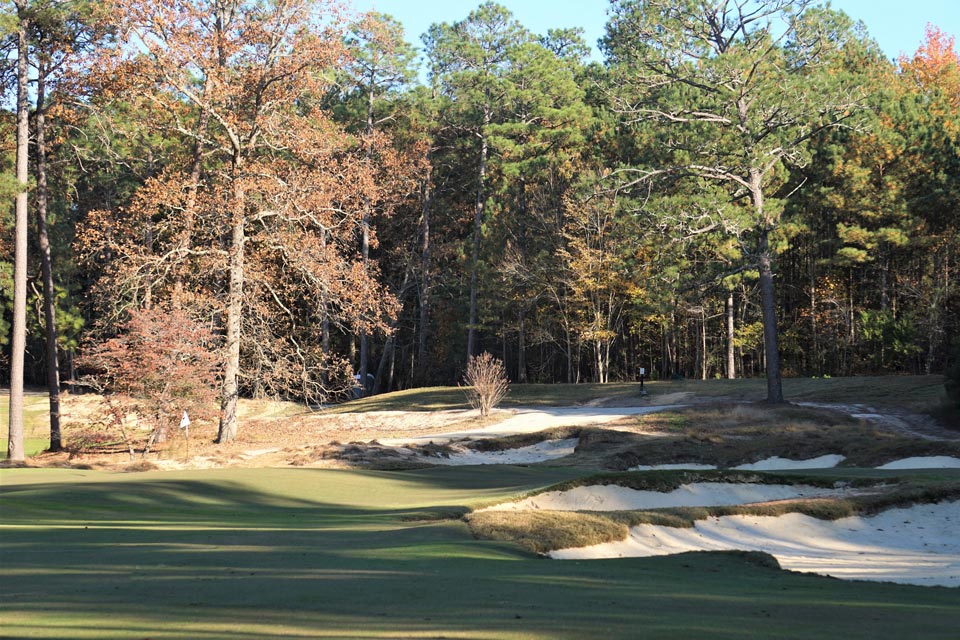
The late afternoon light showcases a St. Andrews-isque mound in the middle of this false front, which can be used to shunt balls right toward the otherwise very difficult to assess right hole locations. In this age where aerial assaults are the norm, it is very fine indeed to see an architect find ways to reward a running approach shot!
Seventh hole, 200 yards; Chris Buie is a particular fan of this one shotter, musing how Ross surely must have been bewitched by the rim of this 150-yard bowl and invested plenty of brain power in figuring out how to include it in his final routing. Without doubt, this is one of course’s most dramatic holes, made even more special by the creation of the course’s largest green. The putting surface extends nearly seventy (!) paces from front to back with a false front that chews up the first fifteen yards. Players can skip shots in now, which is very much in keeping with how Ross had Pinehurst No. 2 play. The sucker pin is front right on a shelf, which brings the right greenside bunker into play. Play from that bunker is especially problematic as it can produce downhill lies to a green that slopes away. Just holding the green can be an accomplishment, so best to avoid that bunker altogether.
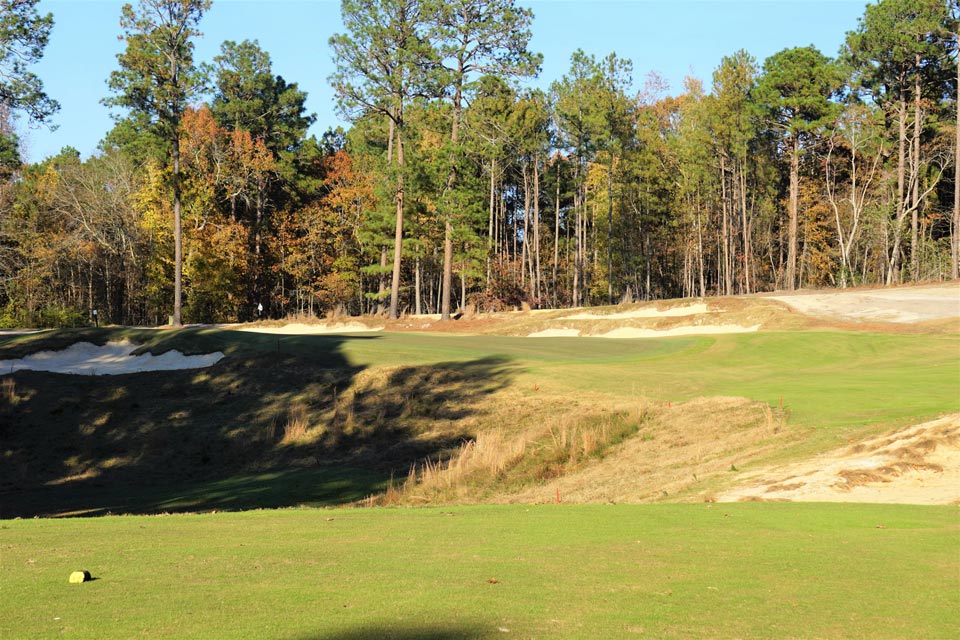
A sandy pit must be crossed from tee to green. As always, Ross affords the golfer the luxury of teeing it up on the infrequent times where forced carries are mandated.
Eighth hole, 385 yards; Both stunning and charming, this slight dogleg right needs to be approached with caution. A driver is not necessarily prudent as finding the fairway is vital with peril lurking on either side. Rapturous applause to Ross for the manner in which he routed the hole along the spine of a hill. Drives missed right kick sharply toward the (now visible) lake while drives pulled left are shunted into the pines. The eighth green is equally neat as the left third is protected by a bunker but it features a bowl contour, allowing the smart golfer to ignore the bunker and let the slope of the green feed the ball down toward the left hole locations. This was arguably the best green from the work done in the 1990s and Franz followed its themes. As you gaze at the photographs below, it is easy to be captivated by the newly credited long views, the impressive bunker scapes and the scale that the hole enjoys. However, don’t overlook the tight mow fall-off to the right of the green, a neat new feature. Recovery from there is much more interesting than from the bunker that used to occupy the spot, that is, assuming that your ball hasn’t kick all the way into the hazard!
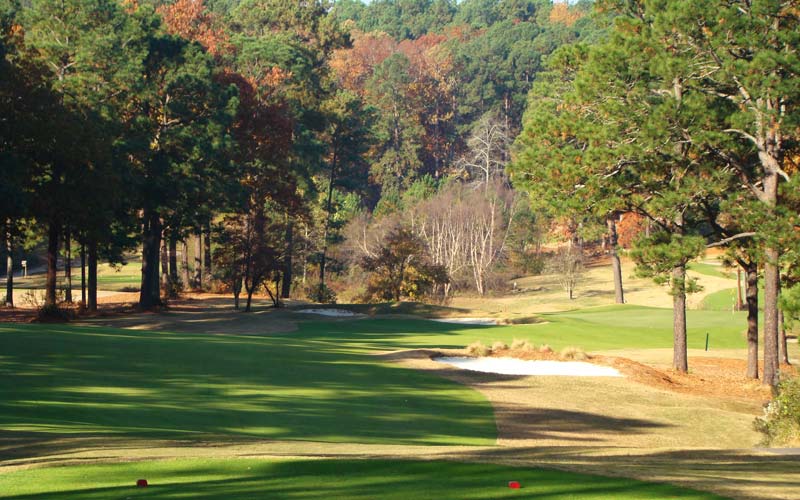
As seen in 2010, pine trees from the right pushed the golfer left and turned the 8th into a conventional dogleg right.
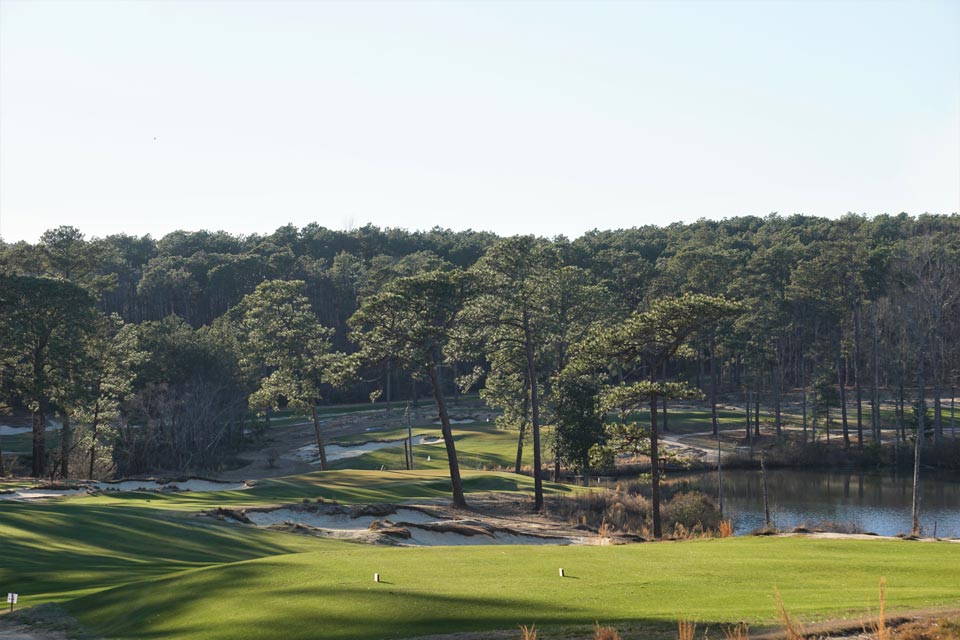
The long views now afforded from the elevated 8th tee are among the most handsome on the property.
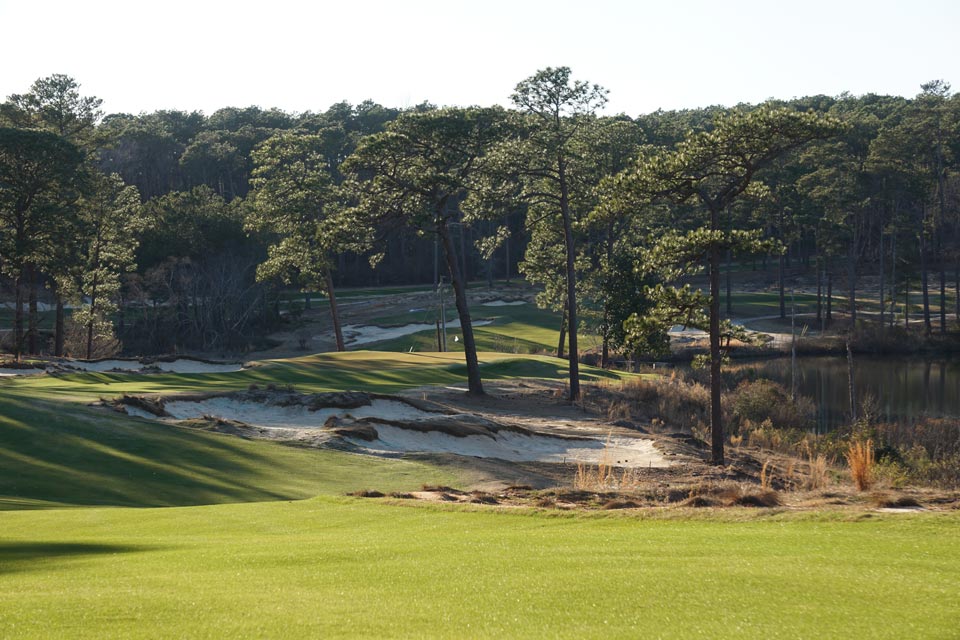
Franz removed the majority of pines along the right, making the golfer infinitely more aware of the six-acre lake. More sunlight hits the fairways than before and the bermuda grasses are thriving from the increased air circulation and sunlight.
Ninth hole, 190 yards; During the Golden Age of architecture, architects had fewer restraints placed on them than their modern peers and were often free to find the routing that yielded the finest sequence of holes. In this case, Ross wasn’t forced to return the first nine to the clubhouse. In fact, over two thousand yards separates the ninth green from the clubhouse and it’s the third par three on this side. Most modern architects don’t enjoy such latitude as they are frequently handcuffed by the allowance for housing and having balanced nines that return.
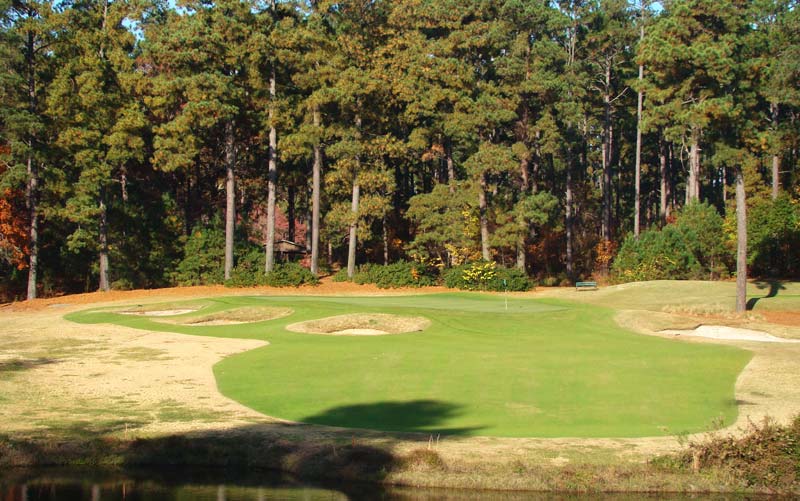
As seen in 2010, the 9th enjoyed good golf qualities though the oval bunkers would never be confused for Ross’s handiwork.
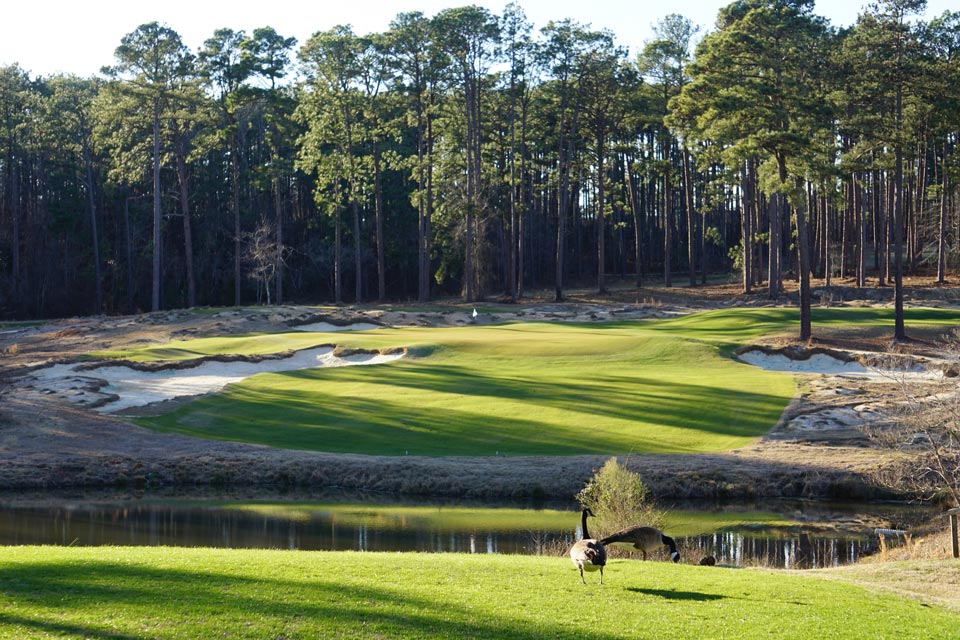
Looks can be deceiving. At first glance, this putting surface appears to be ensconced in sand when in fact it is surrounded by short grass. The back left bunker is 8 paces beyond the putting surface and the front left one was built up to hide all the short grass beyond.
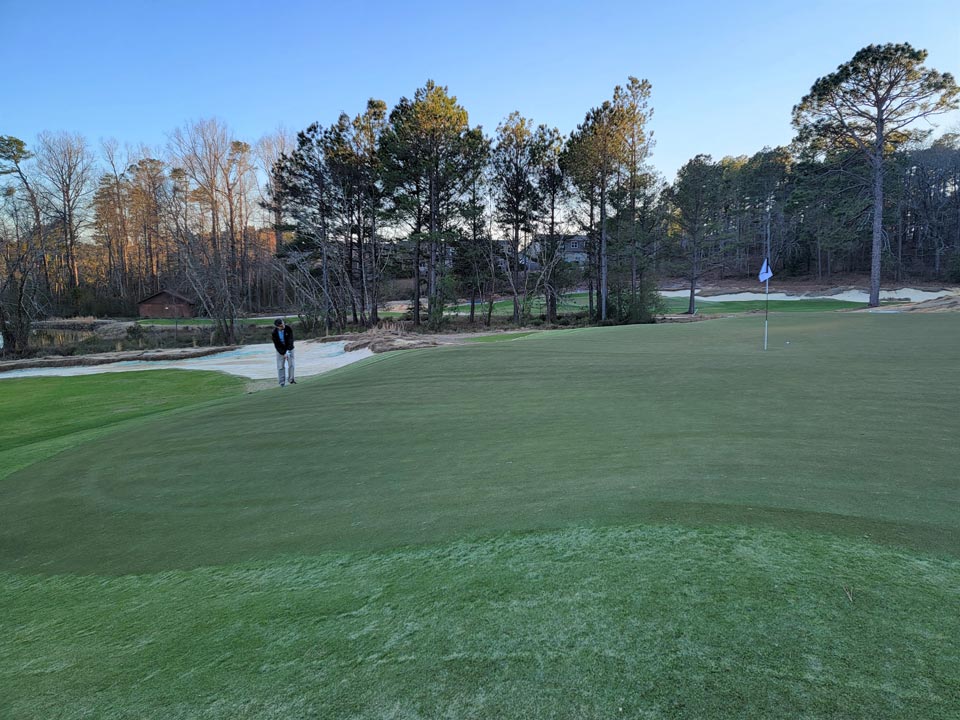
The extent of the false front at the 9th is evident against Chris Buie, who is over six feet tall. Front hole locations, such as this one, are particularly vexing.
Tenth hole, 385 yards; A healthy dose of commonsense exists in restorations. Remove poorly situated trees, restore width/playing angles, make sure the hazards match the course’s newfound scale, improve agronomy, and recapture putting surfaces. All straightforward things. However, moments exist where an architect can shine beyond the norm. And we see striking examples of that over the next four holes. Here, Franz had the idea to move the tee back and left 50 yards, changing the hole from a straightaway 335 yarder to something more interesting. Look at the 2010 picture above of the ninth hole. See beyond the green and the wall of pine trees and bushes? Franz had the inspiration to have all that removed and a new tee installed. The green to tee walk wasn’t lengthened but the hole picked up 50 yards. As made famous at Olympic Golf Club in California, the fairway is reverse camber, meaning the hole flows right-to-left but the fairway slopes left-to-right. A draw is a golfer’s friend off this tee.

The new view from the 10th tee shows an appealing diagonal hazard with the (mostly hidden) fairway beyond.
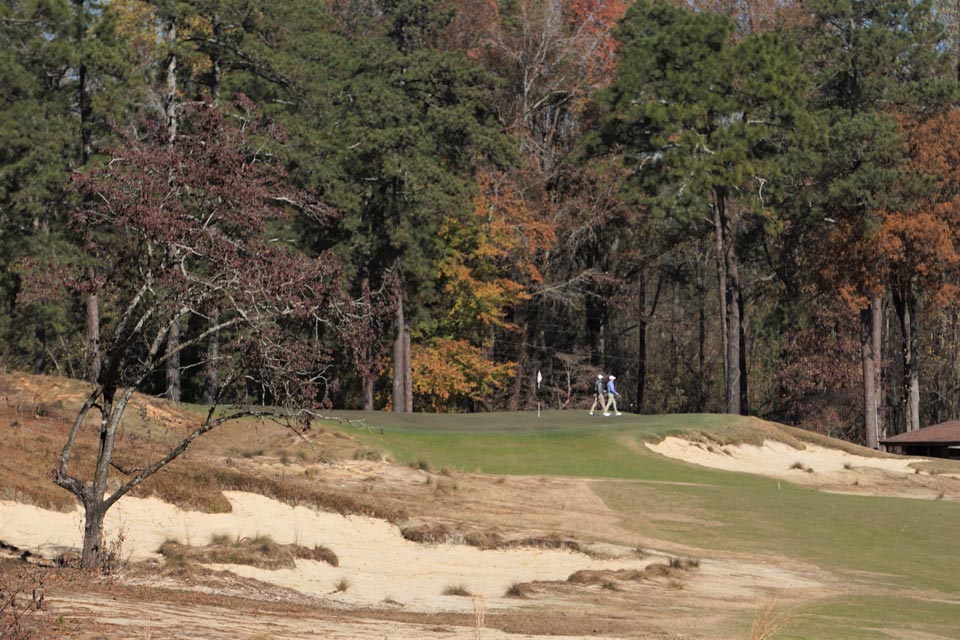
The six-foot deep greenside bunker gets plenty of play, given that the approach shot is often times played with the ball below one’s feet.
Eleventh hole, 320 yards; A sensational hole, one of the best in the state and my favorite on the course. Watching its evolution over the past two decades has been fascinating. In 2000, similar to the eighth, a wall of pines separated the fairway from the lake on the right. Standing on the tee, the player couldn’t see the flag or even the green. Good golfers treated it exclusively as a three wood/pitch hole. In 2007, a management company had the good sense to reduce the forest and provide tempting views of the green/flag. Strong players resumed hitting driver from the tee and the result was as expected: a couple of eagles were made here and there, more birdies and a lot more bogeys and even doubles ensued as tee balls became ensnared by the lake on overzealous tee balls. In the summer of 2021, Franz removed all but one lone pine tree, installed some dazzling bunkers (especially a large one that ends twenty yards short of the putting surface), and pushed the green lower and closer to the lake. Countless permutations exist on how to tackle the hole – with the day’s hole location also having a final say. Before aiming for the green (be it with your tee ball or approach), just know that the left edge of the green is almost four feet higher than the right. The entire strategy revolves around that key fact. For most of us, the real fun is the second shot, a ~60 yarder that many of us now chip with a hooded 7-iron, aiming at the left edge of the green and knowing that the ball will break ~1 yard right for every 3 yards it goes forward. Very fun indeed.
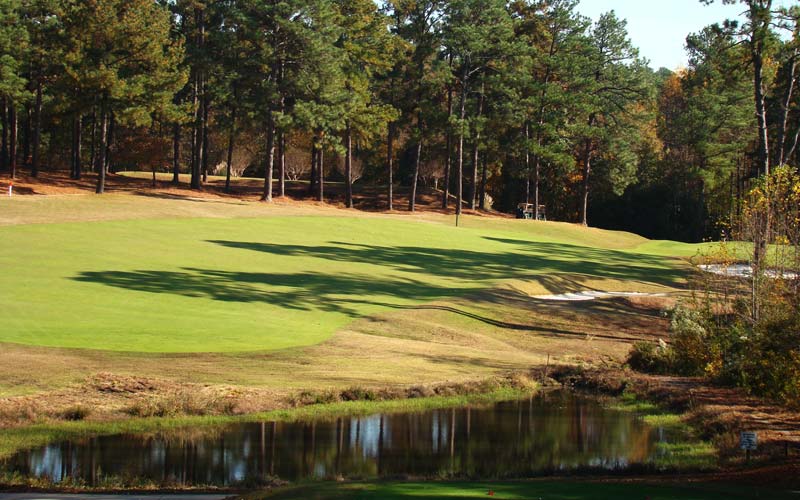
By 2010, much of the green had become visible.
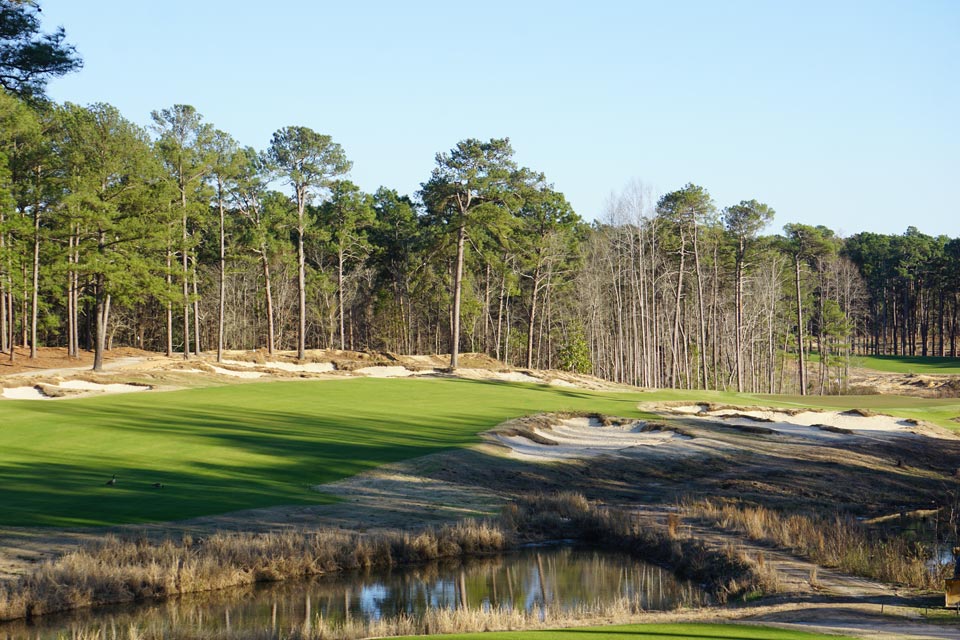
Now look at it – both trouble and opportunity abound! A 270 yard carry gets beyond the last bunker on the right. From there, the ball can bound onto the open putting surface and the question becomes, will it stay on the titled green?
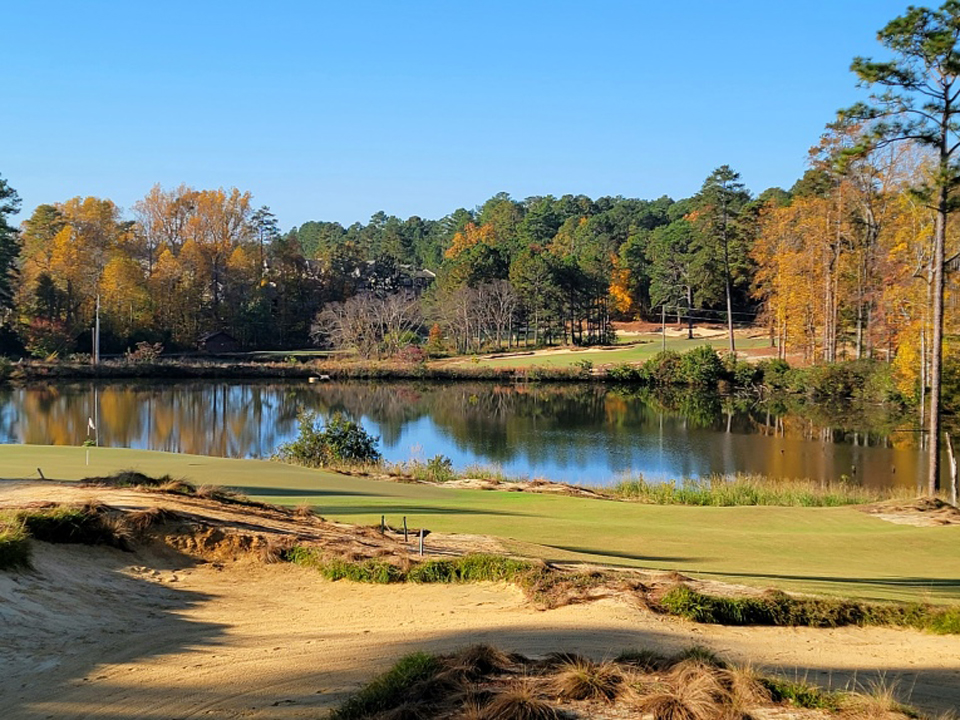
Standing on the tee, the golfer brazenly entertains the idea of birdie – or better. How quickly things can change as a missed tee ball can leave the golfer with the dreaded ~50 yard bunker shot.
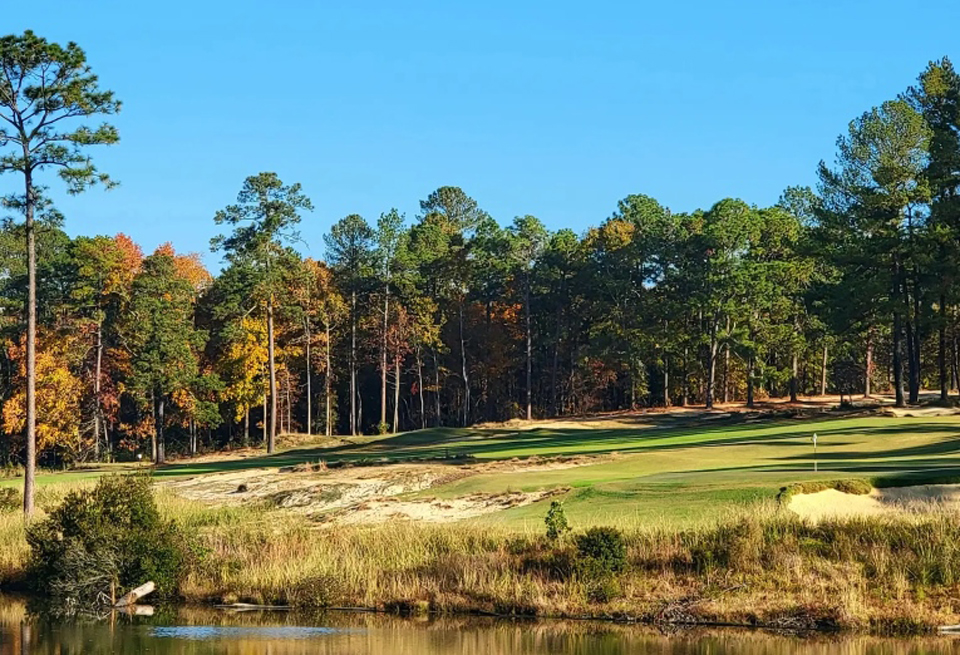
This view from well behind the 11th green illustrates the tilt of the ground that dominates play.
Twelfth hole, 425 yards; Hazards on the sides of holes don’t excite or engage like ones that are directly in the line of play. How could they? Hit the ball straight and you are fine. However, cross hazards impact everyone as they must be carried. Of course, if the architects deploys them too frequently, the golfer can wear down. Finding the right balance is critical. At Southern Pines, Franz used them at each of the three shots holes and no where else, except here. In so doing here, he turned one of less memorable holes visually into one of the most handsome.
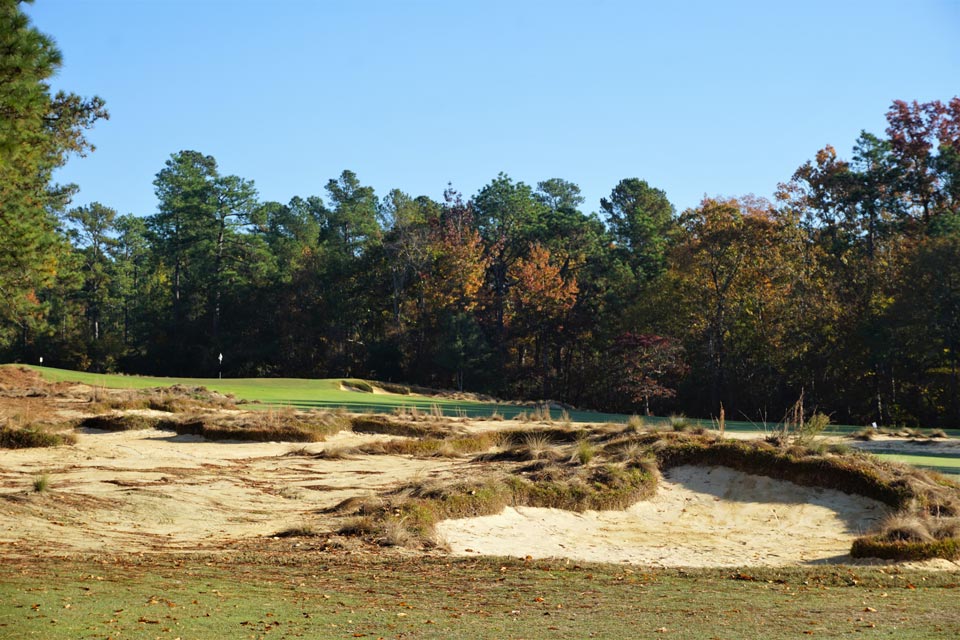
A tee shot long left leaves this ideal approach angle. The rub? Franz lowered the tee and the golfer can’t readily tell that this pocket of fairway exists.
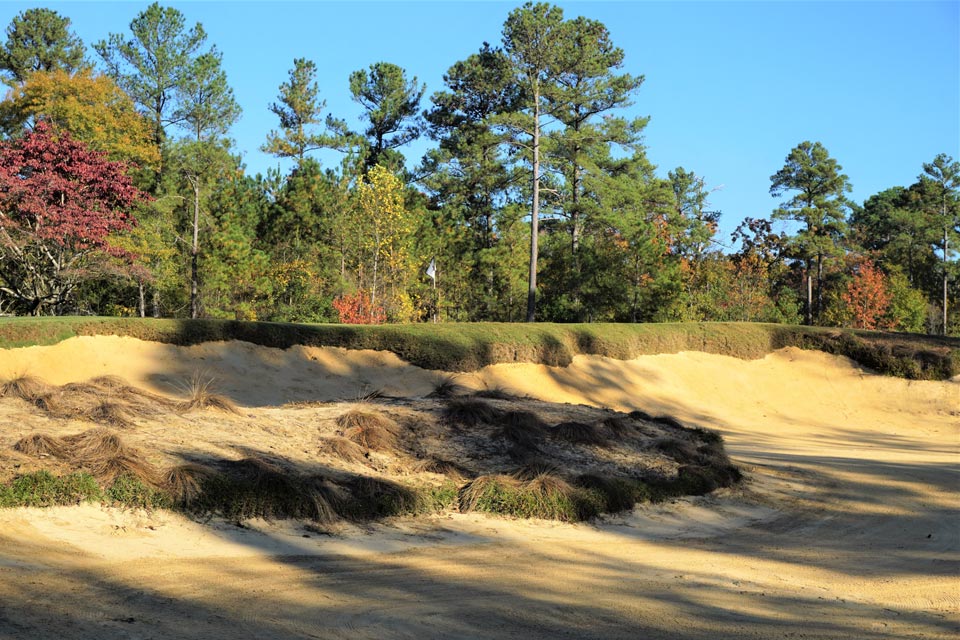
The right greenside bunker places the emphasis on driving left off the tee.
Thirteenth hole, 420 yards; Like many of the next wave of hot architects, Franz is into the history of design and has spent copious hours studying black and white photographs. One that grabbed his attention showed a mound in front of the eighth green at Pinehurst No. 2. Franz hasn’t seen too many such ones like it on Ross courses and this one stuck in his mind. As he says, ‘The appeal of such a feature is that it introduces uncertainty as so many different outcomes can occur depending on how the ball interacts with the mound. Does it hit on the upslope and deaden or hit on the other side and rocket forward? Perhaps it hits on a side and caroms in an awkward direction? Given how the terrain tumbles down to the 13th green and how important the area is before the green, I thought this was an ideal place to introduce this feature. The doubt caused by it is intended to get in the head of a good player while the weaker player rarely minds short grass near as much. ‘ So far, some players love it and others hate it and that means job well done to Franz.
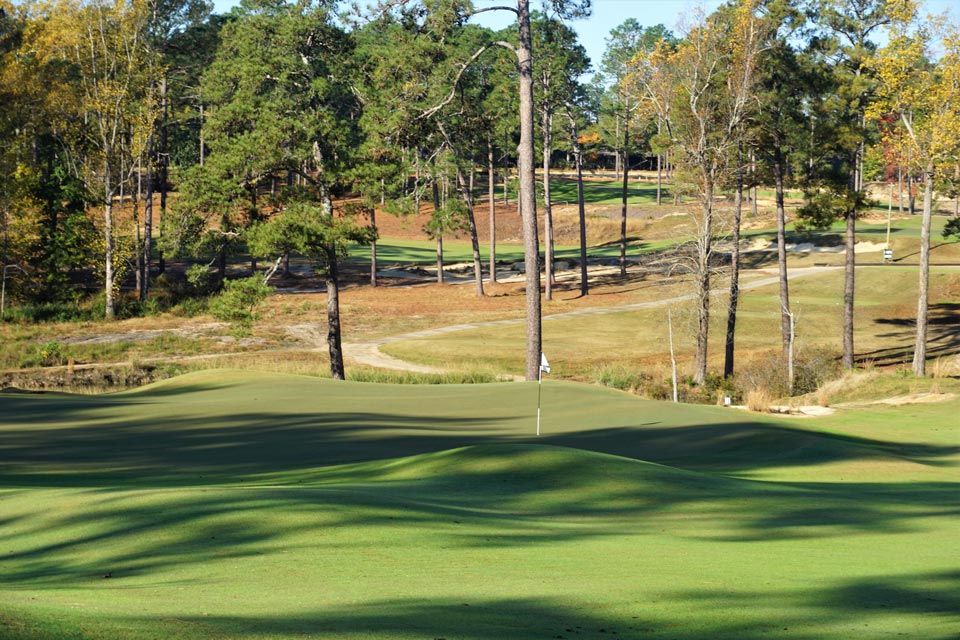
Franz toyed around with a Lion’s Mouth central bunker but ultimately opted for the more inspired choice of a mound to make the approach more interesting at 13.
Fourteenth hole, 175 yards; Measuring 175 yards, the final one shotter is the shortest on the course. Taken as a set, the one shotters average over 190 yards and are likely the root cause of why golfers don’t often score as they had hoped. As we saw at the 9th, Ross employs a one shotter to allow the golfer to cross the waterway in the least painful manner possible. Quasi reverse redan features exist here and seeing a ball kick off the high left side of the green and chase toward Franz’s new found back right hole locations is a highlight. One litmus test for judging the merit of a set of greens is how many ‘fun’ hole locations do they render. The greens at Southern Pines pass that test with distinction.
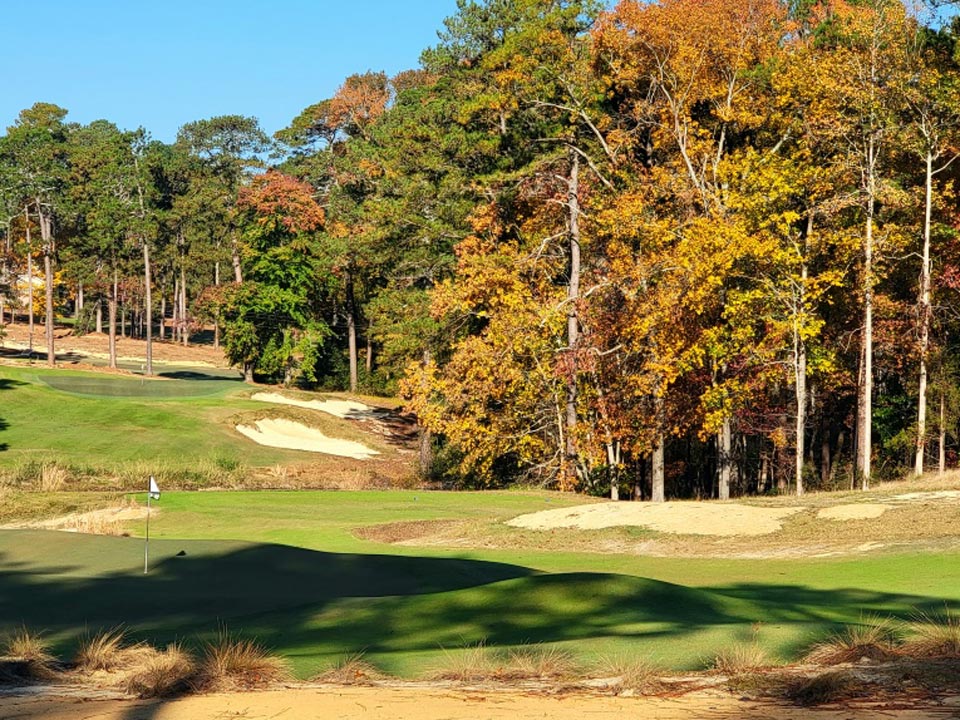
This view across the 13th green of 14 highlights how close knit the greens and tees are.
Fifteenth hole, 430 yards; In the 1990s, an architect created a new tee ~ 100 yards from the fourteenth green and turned this hole into a straightaway 500 yard three shotter. The add length ‘window-dressed’ the scorecard by making the course longer than 6,200. To the author, this hole is more interesting from Ross’s original tee, which is found twenty paces behind the prior green. From there, it plays as a tough 430 yarder as it doglegs to the right and climbs to an elevated green. Requiring the golfer to hit a long approach fits well and adds to the variety of the two shotters on this side. It also perfectly complements the next hole, which is a drive and pitch.
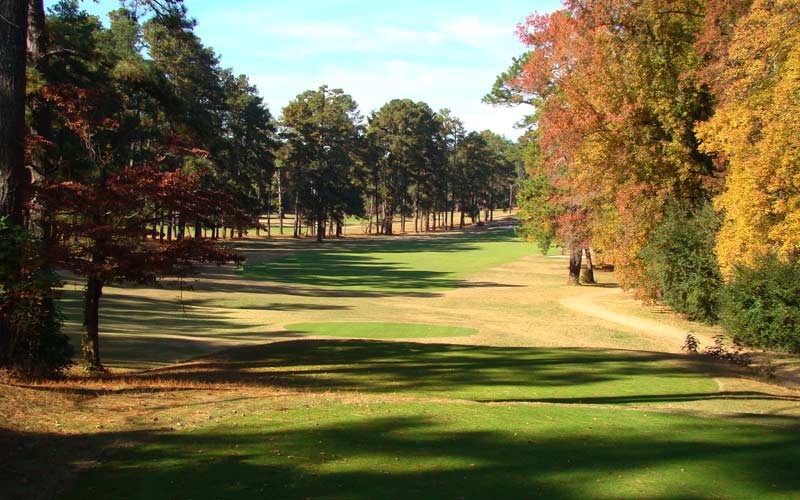
As seen from the Ross tee in 2010, sand wasn’t part of the equation.
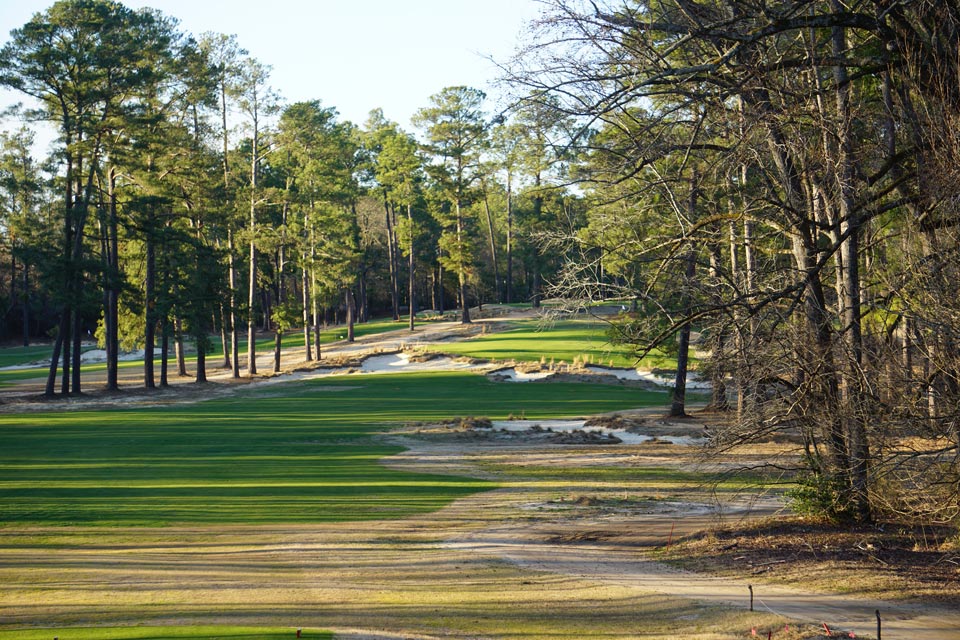
The 15th showcases the harmonious marriage of a wider playing corridor that features both more fairway grass and more sand.
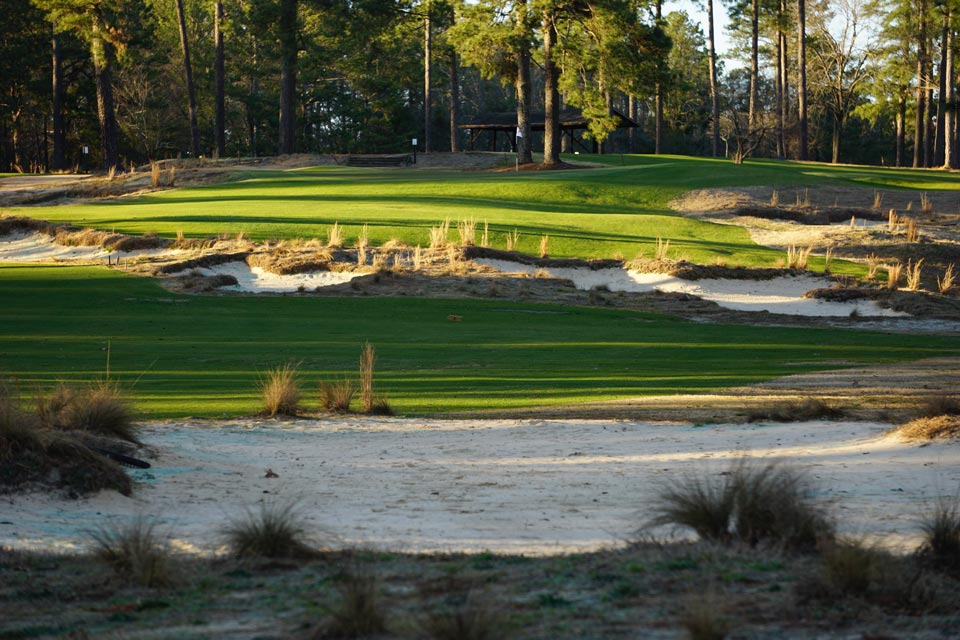
The golfer is left with an attractive ~190 yard uphill approach when playing the 15th from the Ross tees.
Seventeenth hole, 430 yards; With sixteen and eighteen as short two shotters, Franz brings the knives out at the penultimate hole, bunkering it both left and right off the tee. Though the hole itself is straight, the fairway cants right to left, making it a prickly one to hit and hold. The slopped fairway produces a draw for a right-handed golfer’s approach, so Ross added a couple of greenside bunkers left to ‘trap’ the golfer. Franz added more bunkers beyond to lend the hole more visual pop but to his credit, he followed Ross’s lead and kept the entire right side bunker free. In a dream world, the golfer now plays a fade off the tee to gain the preferred angle into the green, and a draw into the green. Arguably, the two most exacting tee shots are the final two.
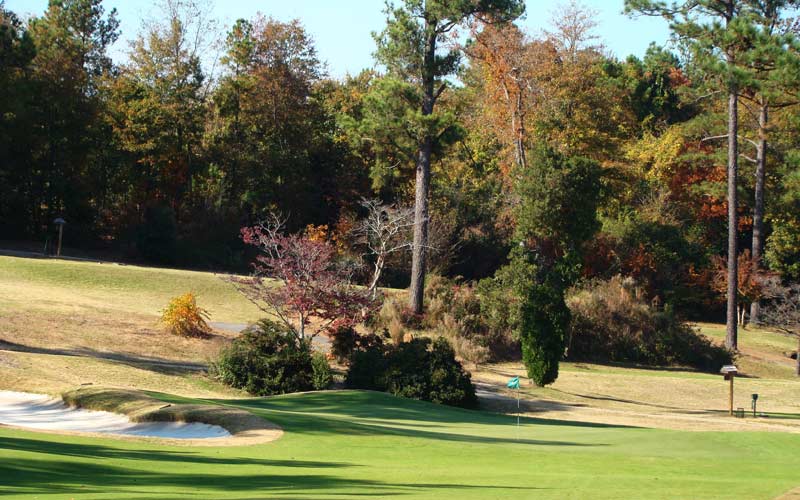
As seen in 2010, there was plenty to like about the 17th.
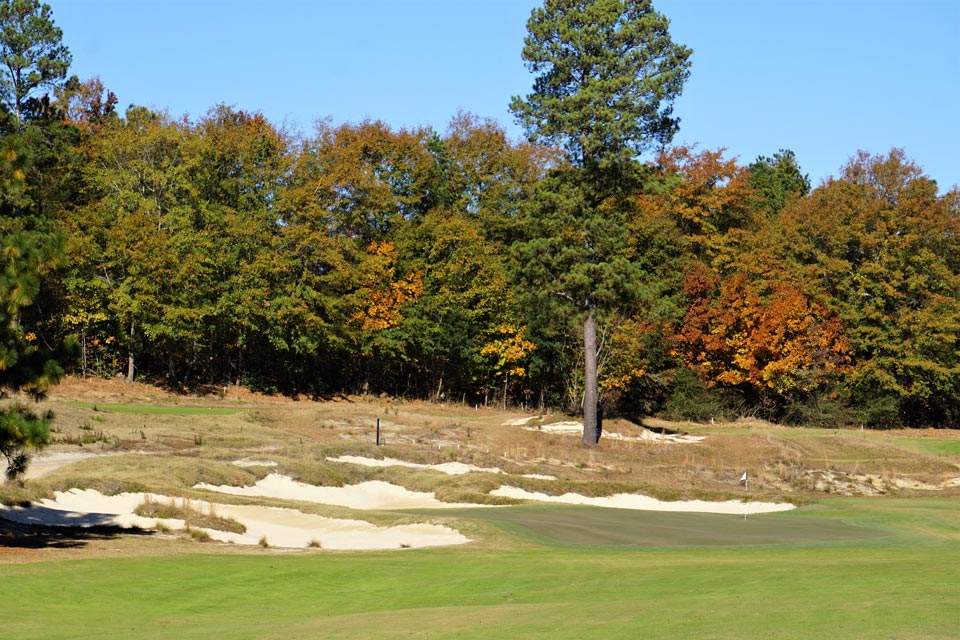
The essence of the approach shot remains similar while the visuals have been greatly enhanced.
Eighteenth hole, 360 yards; A short, two shot finisher has worked at Prestwick, North Berwick and The Old Course at St. Andrews for over 150 years. Yet, when the game crossed the pond, that idea didn’t come with it. Indeed, there may be as many good finishing one shot holes in this country as there are short par fours. Pity that this type of 3 1/2 par finisher lost out in droves to 4 1/2 par finishers. That’s okay, it only helps this former Elks course stand out in the memory bank. Franz’s tee to green bunkering scheme is one of the best on the course. The inside of the dogleg is amply defended from greedy tactics while the ‘pièce de résistance’ is a fairway bunker added on the outside. Completely surrounded by fairway, this bunker engulfs drives ‘missed’ straight. Now the club player no longer automatically reaches for the driver. A tip of the hat to owner Kelly Miller for pushing for this central bunker’s creation. Adding to the puzzle is a knoll 250 yards from the tee in the middle of the fairway that routinely yields awkward stances for one’s approach. More times than one might hope (!), the golfer inadvertently sticks his wedge into the upslope and his uphill approach comes up woefully short. The desired birdie may not materialize but the golfer leaves the course thinking about doing better next time.
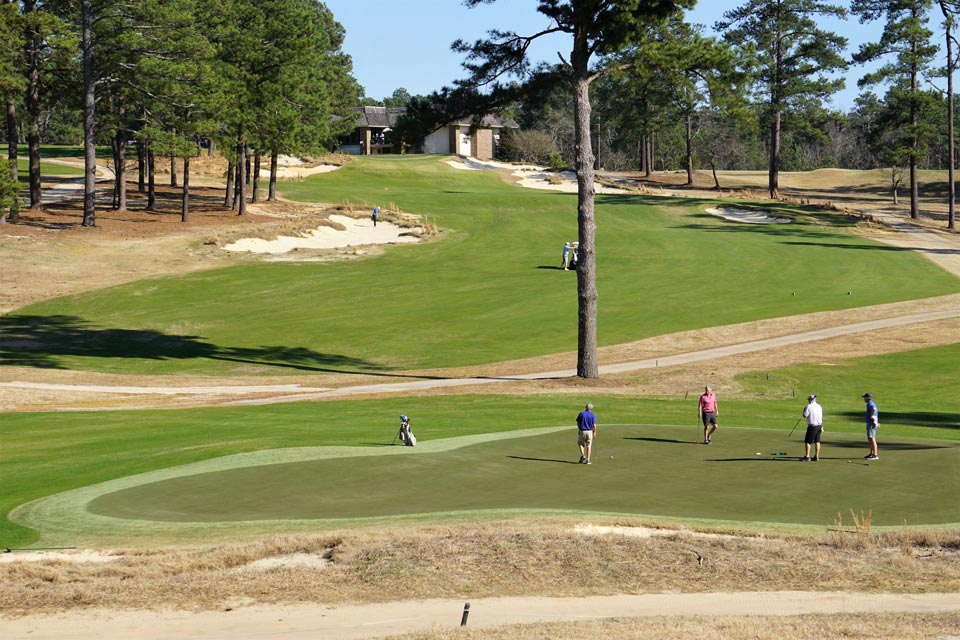
This view across the 17th green shows the 18th fairway as it bends left and heads toward the clubhouse. Photos sourced by Historian Chris Buie and Audrey Moriarty at the Tufts Archives showed Ross’s penchant for building large scale hazards in the 1920s and Franz brought that concept here.
Southern Pines reopened in September, 2021 after Franz’s work and quickly became a darling on social media. Be it aerial drone photos or from ground photos as seen in this profile, the course is photogenic to the nth degree. And why wouldn’t it be?! You have a Ross routing with holes gracefully following across rolling landforms in a variety of appealing ways. Layered on top has been a massive sandscape that is authentic to the region. A monkey could take good pictures (!) but you are here for the golf and each player decides for himself/herself if the course plays as well as it looks. My biased vote is yes it does, in large part because of the interior green contours that Franz installed.
One last thing that Franz did was build a ’19th’ hole, a par three that leads from the fourth green to the fifteenth tee. In theory, it harkens back to the course’s roots of being a nine-holer. Alas, the course is now so popular that the opportunities to cut over to fifteen aren’t normally available! Still, the newly created one shotter is a fine hole and it allows the grounds crew to take a single hole out of play from time to time, as required.

The newly created 140 yarder presents a fun shot and potential abounds to use the bowl green contours to get it close – or even ace – such left hand locations.
Those fixated by playing a ‘championship’ course of 7,000+ yards need head elsewhere. Southern Pines fits in the mold of the 6,600 yard charmers found around London where green-to-tee walks are at a minimum. Swinley Forest, West Sussex and Woking exemplify such clever routings and the Brits have long embraced the virtues of courses where distance accounts for little and charm and character everything. Like those courses, Southern Pines is a dream for those that consider walking a fundamental aspect to the sport. Your feet never hit asphalt and the longest green to tee walk is from the sixth green to the seventh tee, which is sixty-five yards. Southern Pines also shares with U.K. courses another attribute: it is an ideal winter course. The sandy soil drains well and good playing conditions exist year around.
Franz concludes, “This project was a dream. I was given a great routing over great land and asked by a very knowledgeable owner to provide the detail work. And that’s what we did. My time in the area and perusing all the old photos that I could find convinced me that Ross had different styles at different times. His bunkers were quite big and elaborate in the early days and we instilled those qualities into this course. Additionally, the early photographs of Pinehurst No. 2’s greens with grass highlighted just how aggressive Ross could be with green contours. Again, we sought to bring that element forward. The course has enjoyed a cult following, in part because of the GolfClubAtlas contingent, so it was really fun to try and add Ross features that would pass the muster from that critical crowd. So far, Southern Pines has proven to be our most popular work and people have appreciated that we didn’t just do tic tac toe and copycat, paint by numbers stuff. We strived to be innovative with some fun features while always being respectful of Mr. Ross.”
Well said! Suffice to say, much has changed over the past 115+ years here. Work remains to be done to this day, including tee work and continual refinement in how the course presents on a day-to-day basis. Through it all, Southern Pines has retained that simple, yet elusive, attribute of being darn fun to play on a regular basis. Maybe there is a more important design attribute than that, but I am not sure what it would be?! All I know is that I am looking forward to my next thousand rounds here, should the fates be so kind.
The End





![The Park, West Palm (Lit 9) [2023]](https://golfclubatlas.com/wp-content/uploads/2024/12/IMG_7092-2-scaled-500x383.jpg)


